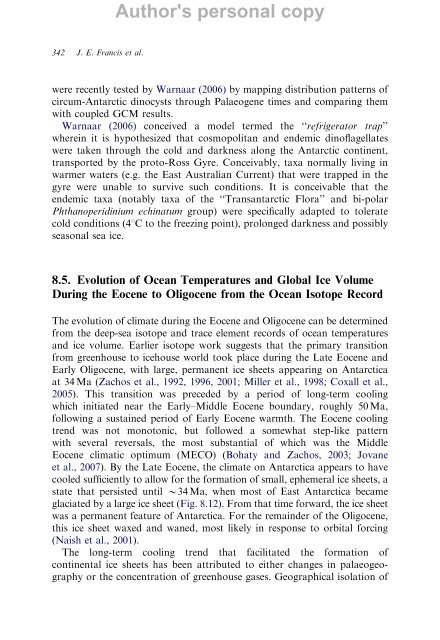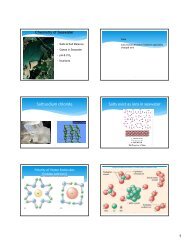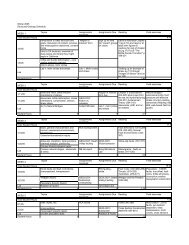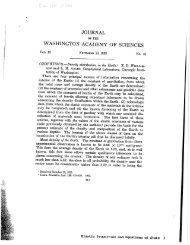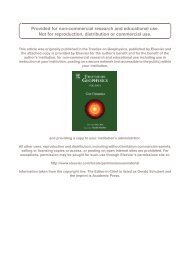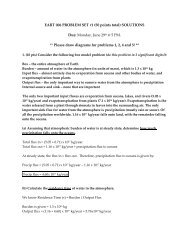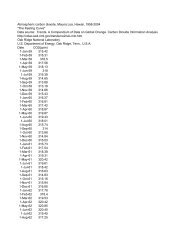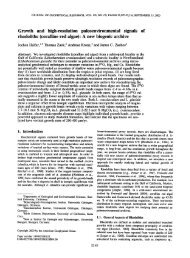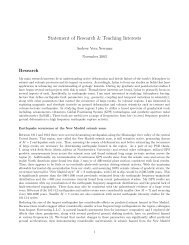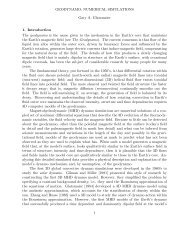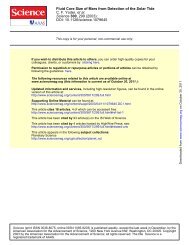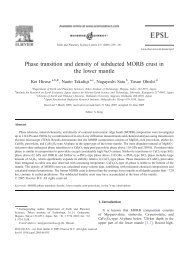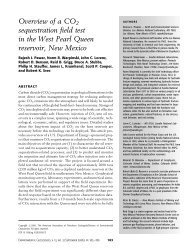From Greenhouse to Icehouse – The Eocene/Oligocene - UMass ...
From Greenhouse to Icehouse – The Eocene/Oligocene - UMass ...
From Greenhouse to Icehouse – The Eocene/Oligocene - UMass ...
You also want an ePaper? Increase the reach of your titles
YUMPU automatically turns print PDFs into web optimized ePapers that Google loves.
342 J. E. Francis et al.<br />
Author's personal copy<br />
were recently tested by Warnaar (2006) by mapping distribution patterns of<br />
circum-Antarctic dinocysts through Palaeogene times and comparing them<br />
with coupled GCM results.<br />
Warnaar (2006) conceived a model termed the ‘‘refrigera<strong>to</strong>r trap’’<br />
wherein it is hypothesized that cosmopolitan and endemic dinoflagellates<br />
were taken through the cold and darkness along the Antarctic continent,<br />
transported by the pro<strong>to</strong>-Ross Gyre. Conceivably, taxa normally living in<br />
warmer waters (e.g. the East Australian Current) that were trapped in the<br />
gyre were unable <strong>to</strong> survive such conditions. It is conceivable that the<br />
endemic taxa (notably taxa of the ‘‘Transantarctic Flora’’ and bi-polar<br />
Phthanoperidinium echinatum group) were specifically adapted <strong>to</strong> <strong>to</strong>lerate<br />
cold conditions (41C <strong>to</strong> the freezing point), prolonged darkness and possibly<br />
seasonal sea ice.<br />
8.5. Evolution of Ocean Temperatures and Global Ice Volume<br />
During the <strong>Eocene</strong> <strong>to</strong> <strong>Oligocene</strong> from the Ocean Iso<strong>to</strong>pe Record<br />
<strong>The</strong> evolution of climate during the <strong>Eocene</strong> and <strong>Oligocene</strong> can be determined<br />
from the deep-sea iso<strong>to</strong>pe and trace element records of ocean temperatures<br />
and ice volume. Earlier iso<strong>to</strong>pe work suggests that the primary transition<br />
from greenhouse <strong>to</strong> icehouse world <strong>to</strong>ok place during the Late <strong>Eocene</strong> and<br />
Early <strong>Oligocene</strong>, with large, permanent ice sheets appearing on Antarctica<br />
at 34 Ma (Zachos et al., 1992, 1996, 2001; Miller et al., 1998; Coxall et al.,<br />
2005). This transition was preceded by a period of long-term cooling<br />
which initiated near the Early<strong>–</strong>Middle <strong>Eocene</strong> boundary, roughly 50 Ma,<br />
following a sustained period of Early <strong>Eocene</strong> warmth. <strong>The</strong> <strong>Eocene</strong> cooling<br />
trend was not mono<strong>to</strong>nic, but followed a somewhat step-like pattern<br />
with several reversals, the most substantial of which was the Middle<br />
<strong>Eocene</strong> climatic optimum (MECO) (Bohaty and Zachos, 2003; Jovane<br />
et al., 2007). By the Late <strong>Eocene</strong>, the climate on Antarctica appears <strong>to</strong> have<br />
cooled sufficiently <strong>to</strong> allow for the formation of small, ephemeral ice sheets, a<br />
state that persisted until B34 Ma, when most of East Antarctica became<br />
glaciated by a large ice sheet (Fig. 8.12). <strong>From</strong> that time forward, the ice sheet<br />
was a permanent feature of Antarctica. For the remainder of the <strong>Oligocene</strong>,<br />
this ice sheet waxed and waned, most likely in response <strong>to</strong> orbital forcing<br />
(Naish et al., 2001).<br />
<strong>The</strong> long-term cooling trend that facilitated the formation of<br />
continental ice sheets has been attributed <strong>to</strong> either changes in palaeogeography<br />
or the concentration of greenhouse gases. Geographical isolation of


